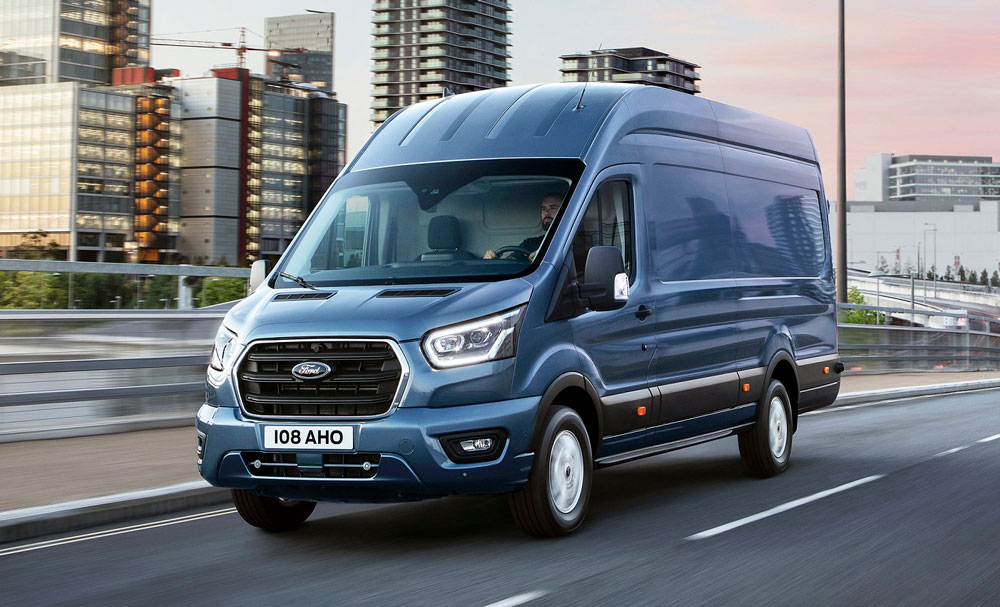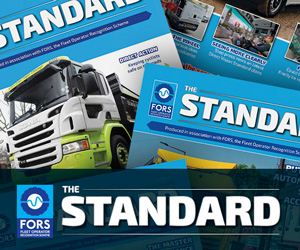
Ford has revealed the new two-tonne Transit model at the IAA Commercial Vehicle show in Hannover, marking the global debut of the smartest and most productive Transit ever.
The new model provides increased load-carrying capability and upgraded powertrains that optimise fuel efficiency by up to 7%. The new Transit also is introduced with a segment-first new diesel mild hybrid (mHEV) powertrain option that delivers an additional fuel efficiency improvement of around 3%, compared with the standard diesel model, with up to 8% in stop-start urban applications.
This is a Ford Transit for the modern business world: it’s as tough and practical as our customers demand, cost of ownership is reduced and its connectivity will improve operational efficiency
The new Transit offers operators the benefits of FordPass Connect on-board modem technology, helping fleet professionals to improve vehicle utilisation and optimise running costs.
On sale in Europe from mid-2019, the new Transit builds on the success of the outgoing model, which has helped to establish the Transit nameplate as the leader in its segment in both Europe and North America. Sales growth in Europe has continued during 2018 with 67,000 vehicles sold in August year-to-date, one third of those in the UK alone.
“This is a Ford Transit for the modern business world – it’s as tough and practical as our customers demand, cost of ownership is reduced and its connectivity will improve operational efficiency,” said Michael McDonagh, Transit global chief programme engineer, Ford of Europe. “Ford is also setting the pace in electrification, with a new mild hybrid powertrain ideal for urban deliveries.”
New looks inside and out
The Transit’s new exterior features a taller, more assertive three-bar grille and a redesigned lower fascia. The front panels and bumper have been re-profiled to improve aerodynamics and create a bolder appearance with uncluttered easy-to-clean surfaces. High-series models feature powerful bi-xenon headlamps and new LED daytime running lights.
In line with the latest Transit Custom, the vehicle has an all-new interior design, providing enhanced style, practicality and driver comfort. The new instrument panel is packed with practical touches for drivers who use the cabin as a mobile office, including significantly improved stowage with three open-topped bins on the top of the dashboard. A new device dock on lower series models enables drivers to mount both mobile phones and later larger tablets.
The interior features attractive and hard-wearing materials, including smart new seat fabrics that have been subjected to Ford’s toughest ever abrasion tests. All-day comfort is further enhanced by new seat designs featuring revised foam padding and geometry for optimised support.
A new Limited series is now available for the growing number of users requiring a high-specification variant to support their business requirements.
Enhanced fuel efficiency, more choice
Ford’s 2.0-litre EcoBlue diesel engine has been further optimised to deliver fuel efficiency improvements of up to 7%. A fuel-injection system that increases peak pressure to 2,200 bar helps achieve more efficient combustion.
To reduce friction within the engine, new steel pistons feature a slimmer skirt design than the out-going cast aluminium design. A variable-flow oil pump reduces parasitic losses by adapting oil delivery to demand.
Further fuel efficiency improvements are achieved with the introduction of electric power-assisted steering (EPAS) to the Transit for the first time, an extensive programme of weight saving, the use of low-rolling resistance tyres and aerodynamic enhancements. Auto Start-Stop remains standard across the range.
The choice of 105PS, 130PS and 170PS power ratings is expanded with the addition of a new 185PS variant, which delivers 415Nm of torque.
From spring 2020, in addition to the standard six speed manual gearbox, rear-wheel drive Transit models will be available with a 10-speed automatic transmission featuring Adaptive Shift Scheduling.
Segment-first mHEV technology
The new Transit introduces diesel mHEV technology as an option, which adds a further improvement of around 3% based on WLTP analysis. Increased benefits of up to 8% can be achieved in applications featuring a high proportion of stop-start driving.
A belt-driven integrated starter/generator replace the standard alternator, enabling recovery and storage of energy during vehicle decelerations, and charging a 48-volt lithium-ion air-cooled battery pack. The stored energy is used to provide torque assistance to the engine under normal driving and acceleration, as well as running the vehicle’s electrical ancillaries.
Increased payload
The new Transit will be among the class leaders for payload, thanks to a programme of weight savings in every area of the vehicle, which has helped deliver increases in load carrying ability.
To achieve these savings, the vehicle design was further optimised using advanced computer-aided engineering systems from the aerospace industry. Weight-saving examples include a new aluminium bonnet, the use of spun steel wheels with varied thicknesses and a single exhaust muffler configuration replacing the outgoing twin-muffler design. For the first time, light, strong composite materials are used for the bulkhead in place of steel.
Ford’s 2.0-litre EcoBlue diesel engine has been further optimised to deliver fuel efficiency improvements of up to 7%
Driving business
The Transit’s character is enhanced with the introduction of EPAS technology that also helps reduce driver fatigue by adding more assistance while parking and manoeuvring, and enables driver assistance technologies including Active Park Assist and Lane- Keeping Aid.
For the first time, Transit drivers will be able to choose from Selectable Drive Modes to match driving performance to conditions: Eco Mode, Slippery Mode, Mud/Rut Mode for all-wheel drive models and Tow/ Haul Mode for smooth power delivery when towing large trailers or boats that weigh more than the vehicle kerb weight. A range of advanced driving assistance technologies have also been introduced. These include:
- Blind Spot Information System with Trailer Tow system, featuring an extended blind spot zone that covers the vehicle plus a trailer of up to 10 metres
- Intelligent Adaptive Cruise Control, which combines Traffic Sign Recognition and Adaptive Cruise Control to help drivers stay within legal speed limits
- Enhanced Lane-Keeping System
- Pre-Collision Assist with Pedestrian Detection, now capable of detecting pedestrians at night when they are illuminated by the headlamps
New features are also provided to make life easier and less stressful when manoeuvring and parking within busy commercial and urban environments. These include:
- Front and Rear Wide-View Cameras to help drivers view oncoming traffic when edging out of a narrow parking space, on busy roads or when reversing
- High mounted rear-view camera, positioned to offer better visibility when reversing
- Parking Aid, enhanced with additional side sensors
- Active Park Assist (APA), which helps drivers find suitable spaces and park hands‑free nose-to-tail or side by- side with other vehicles
- Park-Out Assist, which helps drivers exit parallel parking spaces hands-free
- Cross Traffic Alert warns drivers reversing out of a parking space of vehicles that be crossing behind them.


